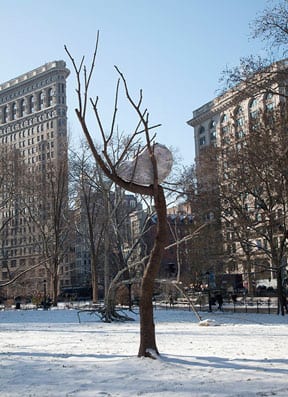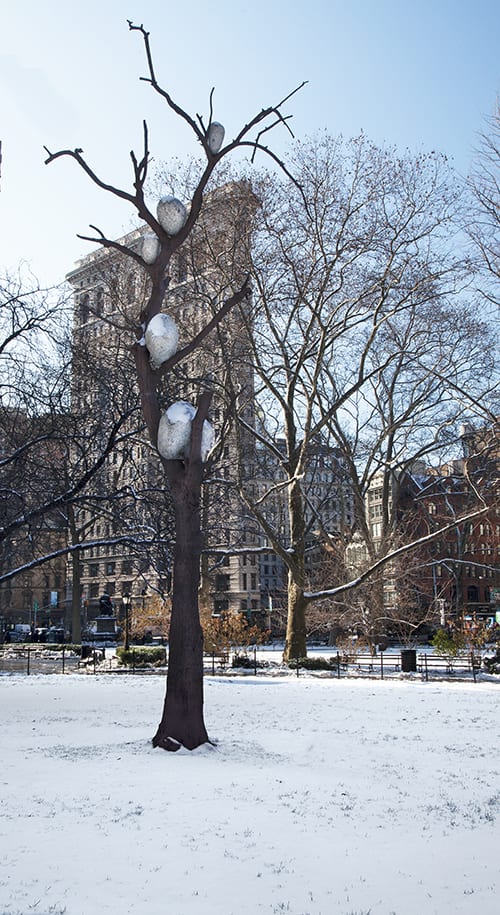An installation is greatly influenced by its surrounding environment. In Issue 29 we first introduced Giuseppe Penone’s installation Ideas of Stone at Madison Square Park. Now that the seasons have changed, so too has the perspective of Madison Square Park’s senior curator Brooke Kamin Rapaport. As the installation approaches its conclusion on February 9, Rapaport shares her thoughts regarding Penone’s impact on the New York City landscape.
The public has been mesmerized by Penone’s sculpture in Madison Square Park. In September, people watched fascinated as the installation unfold each day. It was a choreographed process with the artist, a team of installers and landscapers and a 127 foot crane all conspiring to assemble the thirty-foot high 7,000, 10,000 and 12,000 pound bronze trees with river boulders tucked into their branches. My colleagues at the Madison Square Park Conservancy have also been tracking the outpouring of Penone images on social media. More recently – as the January snowstorms have covered the park in white – the works have assumed the quiet dignity of venerableness.
How have the changing seasons and natural elements affected the impact of the installation?
We have had the great fortune to witness the work’s transformation across three seasons: late summer, autumn and now winter. When park visitors and leafy green trees served as the backdrop for Giuseppe’s own towering bronze trees, there was a vital, animate presence to the sculptures. People would sit right up against the work and almost will an essential or elemental force to its presence. When the park landscape became rich with fall colors and changing leaves, the sculptures were in stark contrast to the vibrancy of the site. Now during the winter, the spare, austere forms of the park’s natural trees are in league with Giuseppe’s art.

Over the duration of the installation, how has your perspective of the work changed?
I have watched – both on site in the park and from a window with a bird’s eye view of Madison Square Park’s Oval Lawn – the transformation of these works across the seasons. It has been deeply moving to observe how the sculpture seamlessly integrates into the surroundings, the great but subtle power in these works have become highlighted.
How has your relationship with the artist evolved?
Giuseppe is a distinguished sculptor and it has been a privilege for Madison Square Art to host his first outdoor exhibition in New York City. If his work was not as familiar to some New Yorkers as it was to Europeans, perhaps we have changed this.

What have you learned as a curator taking on such an ambitious project?
One of the great lessons of this project for me was to observe and consider the artist’s deliberate and thoughtful siting of his work. Giuseppe was exacting as he circumnavigated the Oval Lawn just before the sculptures were installed. He wanted the placement of the works to be perfect so that they would be best seen across the seasons. Of course he was right.
Featured image: Installation view of Giuseppe Penone’s Ideas of Stone (Idee di pietra) in Madison Square Park, 2013, photography by Malcolm Varon, © of Madison Square Park Conservancy
All images © Photo by Malcolm Varon, New York. Courtesy of the artist and Marian Goodman Gallery, New York/Paris.
